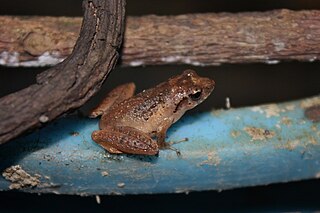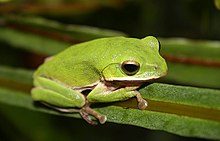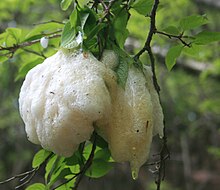
The Rhacophoridae are a family of frogs that occur in tropical sub-Saharan Africa, South India and Sri Lanka, Japan, northeastern India to eastern China and Taiwan, south through the Philippines and Greater Sundas, and Sulawesi. They are commonly known as shrub frogs, or more ambiguously as "moss frogs" or "bush frogs". Some Rhacophoridae are called "tree frogs". Among the most spectacular members of this family are numerous "flying frogs".

The Rhacophorinae are a subfamily of frogs in the family Rhacophoridae. They range from tropical Africa and Asia to temperate China and Japan.

Theloderma, the bug-eyed frogs, mossy frogs or warty frogs, is a genus of frogs in the family Rhacophoridae, subfamily Rhacophorinae. They are found from northeastern India and southern China, through Southeast Asia, to the Greater Sunda Islands; the highest species richness is in Indochina. Some species, especially T. corticale, are sometimes kept in captivity.

Rhacophorus is a genus of frogs in the shrub-frog family Rhacophoridae, which, with the related Hylidae, is one of the two genera of true tree frogs. They are found in China, India, Japan, and throughout Southeast Asia, including the island of Borneo. Over 40 species are currently recognised.

Amolops is a genus of true frogs native mainly to eastern and south-eastern Asia. These frogs are closely related to such genera as Huia, Meristogenys, Odorrana, Pelophylax and Rana, but still form a distinct lineage among the core radiation of true frogs. They are commonly known as "torrent frogs" after their favorite habitat - small rapid-flowing mountain and hill streams - but this name is used for many similar-looking frogs regardless of whether they are loosely related.

Zhangixalus arvalis is a species of frog in the family Rhacophoridae. It is endemic to western and southwestern Taiwan and is present in agricultural areas of Chiayi, Yunlin, and Tainan Counties. Common name farmland green treefrog has been coined for it.

Zhangixalus aurantiventris is a species of frog in the family Rhacophoridae. It is endemic to Taiwan. It is known from scattered localities across Taiwan at low to mid altitudes.

Zhangixalus moltrechti is a species of frog in the family Rhacophoridae. It is endemic to Taiwan, where it has a wide distribution in hilly areas. Common names Moltrecht's green treefrog, Moltrecht's treefrog, Taiwan treefrog, and Nantou flying frog have been coined for it.

Zhangixalus prasinatus is a species of frog in the family Rhacophoridae endemic to northern Taiwan. It has been observed between 400 and 600 meters above sea level.

Gracixalus is a genus of shrub frogs from south-eastern Asia.

Liuixalus is a small genus of rhacophorid frogs that are distributed in southern China. Some species now in Liuixalus were originally placed in Philautus. It is thought to be the most basal genus in the Rhacophorinae.
Zhangixalus jodiae, also known as Jodi's treefrog, is a species of frog in the family Rhacophoridae. It is named in honour of Jodi Rowley, Australian herpetologist, for her "great contribution to amphibian taxonomy in Asia". Zhangixalus jodiae is endemic to northeastern Vietnam and is only known from the vicinity of its type locality in Quản Bạ District, Hà Giang Province. It belongs to a clade of Zhangixalus inhabiting karst forests of southern China and northern Vietnam.

Boulenophrys is a genus of frogs in the family Megophryidae. They occur in the China, Mainland Southeast Asia and Northeast India. It had been placed variously as a subgenus or synonymy of Megophrys. Dubois, Ohler and Pyron first recognized that Panophrys is preoccupied and employed Boulenophrys as the generic name rather than Tianophrys under the Principle of First Revisor.
Zhangixalus franki, or Frank's tree frog, is a species of frog in the family Rhacophoridae. It has been reported in China, in Yunnan Province, and in northern Vietnam, between 1320 and 1360 m above sea level.
Zhangixalus wui, the Lichuan tree frog, is a species of frog in the family Rhacophoridae. It is endemic to China. Scientists know it exclusively from the type locality: Hanchi Village in Hubei Province. It has been observed between 1550 and 1840 meters above sea level.
Zhangixalus hongchibaensis, the Wuxi tree frog, is a frog in the family Rhacophoridae. Scientists know it from the type locality: Hongchiba in Wuxi County, Chongqing Province, China. It has been observed 1747 meters above sea level.
Zhangixalus lishuiensis is a species of frog in the family Rhacophoridae. Scientists know it exclusively from the type locality: Fengyang Forest Station in Zhejiang Province, China. It has been observed 1100 meters above sea level.
Rhacophorus vanbanicus, the Van Ban treefrog, is a frog. It is endemic to Vietnam. Scientists know it exclusively from the type locality, 900 meters above sea level in the Van Ban District. It is suspected in China's Yunnan Province.
Rhacophorus hoabinhensis, the Hoa Binh tree frog, is a species of frog in the family Rhacophoridae. It is endemic to Vietnam. Scientists know it exclusively from the type locality: Hang Kia–Pa Co Nature Reserve, 1350 meters above sea level.













